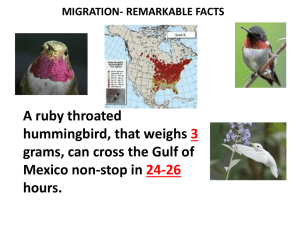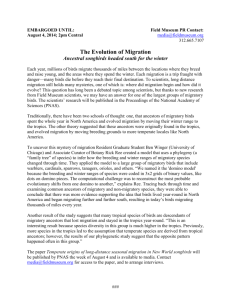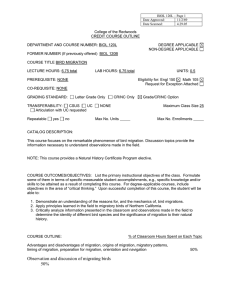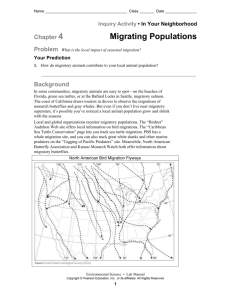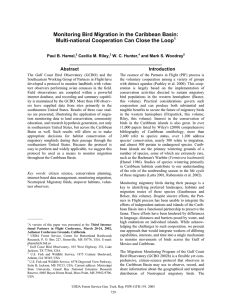“Commuting on the Wing” an introduction to bird migration
advertisement
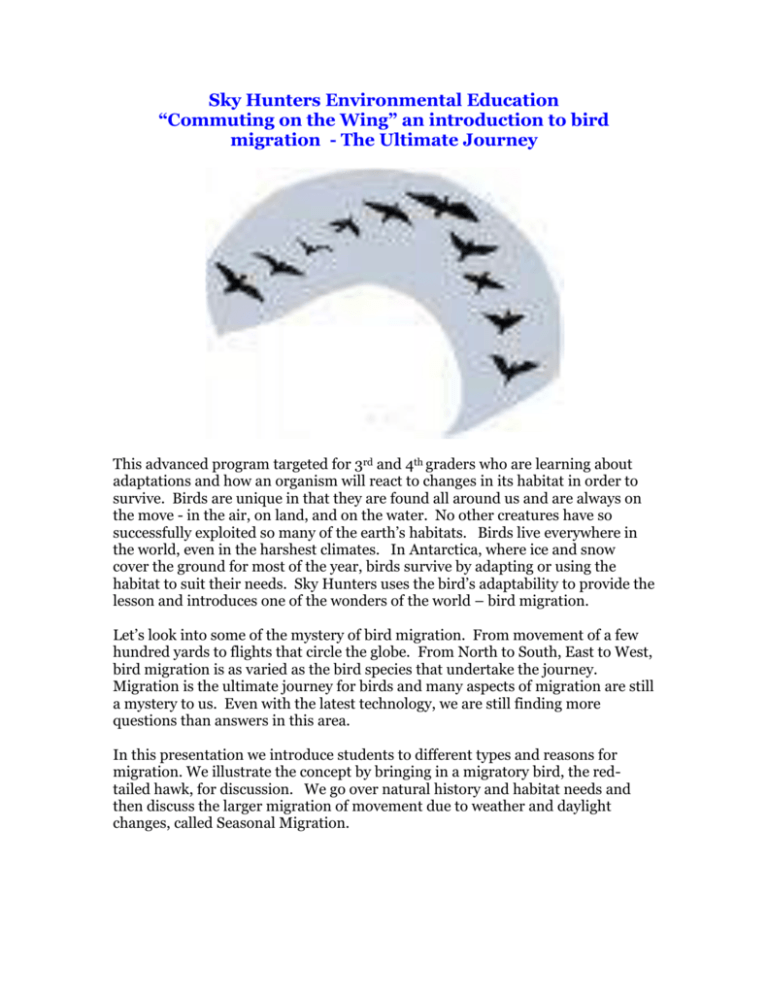
Sky Hunters Environmental Education “Commuting on the Wing” an introduction to bird migration - The Ultimate Journey This advanced program targeted for 3rd and 4th graders who are learning about adaptations and how an organism will react to changes in its habitat in order to survive. Birds are unique in that they are found all around us and are always on the move - in the air, on land, and on the water. No other creatures have so successfully exploited so many of the earth’s habitats. Birds live everywhere in the world, even in the harshest climates. In Antarctica, where ice and snow cover the ground for most of the year, birds survive by adapting or using the habitat to suit their needs. Sky Hunters uses the bird’s adaptability to provide the lesson and introduces one of the wonders of the world – bird migration. Let’s look into some of the mystery of bird migration. From movement of a few hundred yards to flights that circle the globe. From North to South, East to West, bird migration is as varied as the bird species that undertake the journey. Migration is the ultimate journey for birds and many aspects of migration are still a mystery to us. Even with the latest technology, we are still finding more questions than answers in this area. In this presentation we introduce students to different types and reasons for migration. We illustrate the concept by bringing in a migratory bird, the redtailed hawk, for discussion. We go over natural history and habitat needs and then discuss the larger migration of movement due to weather and daylight changes, called Seasonal Migration. In the northern hemisphere, bird fly south in fall to wintering grounds where they can escape the cold weather and find plentiful food. In spring, they fly back to their breeding ground where the weather has produced new growth for renewed food sources, extended daylight for locating food, and space for each individual to successfully raise its family. North to South bird migration may have begun during the Ice Age, or Pleistocene. The southern advance of glaciers and the resulting seasons forced birds southward in the colder, darker months, yet allowed their return in summer to traditional breeding grounds. Food shortage, associated with colder weather, may have forced less hardy species southward to warmer climates. Yet the long light periods of the northern summers offer longer daylight hours for gathering the food and an enormous food supply, allowing the young to grow quickly out of the vulnerable dependency state of nestlings and fledglings. This would be very important for the young to be able to fly long distances in a short period of time, as the northern summers are relatively brief and the short, cold days of winter are not far behind. As the concept of migration is firmly in place, we bring out one of the owls, a nonmigratory species and discuss the benefits of enduring the colder winter weather and decline in food supply by staying put. These birds have developed special adaptations for surviving winters on the breeding grounds, allowing them to get a jump start on nesting and rearing their young before other migrants return in the spring. We introduce weather patterns such as winds, lift and thermals as well as magnetic pull and how birds use landmarks and the stars to guide their way. Migration evolved differently for different species. When a species could gain an advantage by making a periodic shift from one area to another, it developed a migratory pattern that passed from generation to generation. We are seeing some of the migratory patterns of birds changing in our lifetime. Anna’s hummingbirds no longer leave our mild California climates as people have changed the environment by planting exotic flowering shrubs that produce flowers and food for the hummingbirds during the winter months. Many individual Canada geese stay in our parks and golf courses year-round instead of migrating. Global warming is causing food supplies to shift, therefore nesting behavior of sea birds has changed. Sky Hunters Environmental Education PO Box 3026, Los Altos, CA 94024-0026 http://www.sky-hunters.org 650-743-4219


